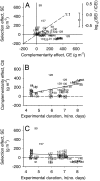Impacts of plant diversity on biomass production increase through time because of species complementarity
- PMID: 17991772
- PMCID: PMC2084307
- DOI: 10.1073/pnas.0709069104
Impacts of plant diversity on biomass production increase through time because of species complementarity
Abstract
Accelerating rates of species extinction have prompted a growing number of researchers to manipulate the richness of various groups of organisms and examine how this aspect of diversity impacts ecological processes that control the functioning of ecosystems. We summarize the results of 44 experiments that have manipulated the richness of plants to examine how plant diversity affects the production of biomass. We show that mixtures of species produce an average of 1.7 times more biomass than species monocultures and are more productive than the average monoculture in 79% of all experiments. However, in only 12% of all experiments do diverse polycultures achieve greater biomass than their single most productive species. Previously, a positive net effect of diversity that is no greater than the most productive species has been interpreted as evidence for selection effects, which occur when diversity maximizes the chance that highly productive species will be included in and ultimately dominate the biomass of polycultures. Contrary to this, we show that although productive species do indeed contribute to diversity effects, these contributions are equaled or exceeded by species complementarity, where biomass is augmented by biological processes that involve multiple species. Importantly, both the net effect of diversity and the probability of polycultures being more productive than their most productive species increases through time, because the magnitude of complementarity increases as experiments are run longer. Our results suggest that experiments to date have, if anything, underestimated the impacts of species extinction on the productivity of ecosystems.
Conflict of interest statement
The authors declare no conflict of interest.
Figures


Similar articles
-
Biodiversity simultaneously enhances the production and stability of community biomass, but the effects are independent.Ecology. 2013 Aug;94(8):1697-707. doi: 10.1890/12-1334.1. Ecology. 2013. PMID: 24015514
-
Effects of algal diversity on the production of biomass in homogeneous and heterogeneous nutrient environments: a microcosm experiment.PLoS One. 2008 Jul 30;3(7):e2825. doi: 10.1371/journal.pone.0002825. PLoS One. 2008. PMID: 18665221 Free PMC article.
-
Plant-animal diversity relationships in a rocky intertidal system depend on invertebrate body size and algal cover.Ecology. 2014 May;95(5):1308-22. doi: 10.1890/13-1480.1. Ecology. 2014. PMID: 25000762
-
Changes in the abundance of grassland species in monocultures versus mixtures and their relation to biodiversity effects.PLoS One. 2013 Sep 30;8(9):e75599. doi: 10.1371/journal.pone.0075599. eCollection 2013. PLoS One. 2013. PMID: 24098704 Free PMC article.
-
Resource Availability Alters Biodiversity Effects in Experimental Grass-Forb Mixtures.PLoS One. 2016 Jun 24;11(6):e0158110. doi: 10.1371/journal.pone.0158110. eCollection 2016. PLoS One. 2016. PMID: 27341495 Free PMC article.
Cited by
-
Plant-soil feedbacks provide an additional explanation for diversity-productivity relationships.Proc Biol Sci. 2012 Aug 7;279(1740):3020-6. doi: 10.1098/rspb.2012.0285. Epub 2012 Apr 11. Proc Biol Sci. 2012. PMID: 22496190 Free PMC article.
-
Mechanisms driving diversity-productivity relationships differ between exotic and native communities and are affected by gastropod herbivory.Oecologia. 2016 Apr;180(4):1025-36. doi: 10.1007/s00442-015-3395-2. Epub 2015 Aug 4. Oecologia. 2016. PMID: 26235964 Free PMC article.
-
The effect of tree species diversity on fine-root production in a young temperate forest.Oecologia. 2012 Aug;169(4):1105-15. doi: 10.1007/s00442-012-2259-2. Oecologia. 2012. PMID: 22298110
-
Biodiversity-ecosystem functioning relationships in long-term time series and palaeoecological records: deep sea as a test bed.Philos Trans R Soc Lond B Biol Sci. 2016 May 19;371(1694):20150282. doi: 10.1098/rstb.2015.0282. Philos Trans R Soc Lond B Biol Sci. 2016. PMID: 27114583 Free PMC article.
-
Bottom-up effects of host-plant species diversity and top-down effects of ants interactively increase plant performance.Proc Biol Sci. 2012 Nov 7;279(1746):4464-72. doi: 10.1098/rspb.2012.0893. Epub 2012 Sep 5. Proc Biol Sci. 2012. PMID: 22951745 Free PMC article.
References
-
- Loreau M, Naeem S, Inchausti P, Bengtsson J, Grime JP, Hector A, Hooper DU, Huston MA, Raffaelli D, Schmid B, et al. Science. 2001;294:804–808. - PubMed
-
- Tilman D. Ecology. 1999;80:1455–1474.
-
- Naeem S, Chapin FS, III, Costanza R, Ehrlich PR, Golley FB, Hooper DU, Lawton JH, O'Neill RV, Mooney HA, Sala OE, et al. Issues in Ecology. 1999;4:1–11.
-
- Sala OE, Chapin FS, Armesto JJ, Berlow E, Bloomfield J, Dirzo R, Huber-Sanwald E, Huenneke LF, Jackson RB, Kinzig A, et al. Science. 2000;287:1770–1774. - PubMed
-
- Daily GC. Nature's Services: Societal Dependence on Natural Ecosystems. Washington, DC: Island; 1997.
Publication types
MeSH terms
LinkOut - more resources
Full Text Sources
Other Literature Sources

